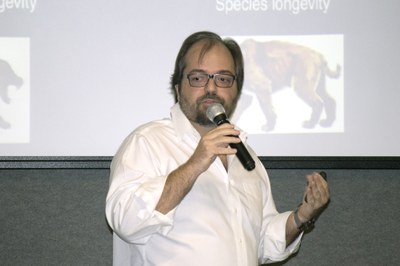Fossils as a Tool to Analyze the Dynamics of Biodiversity

According to Quental, there are two types of data that act as “time machines” in our understanding of biodiversity: the genome and the fossil record. In the case of the genome, our job is to use it in a historical way: “We have sequenced the DNA of different species and reconstructed a diagram of what we call phylogenetic tree, which basically shows the relationships between different species.”
Another important feature of the genome is the fact that it accumulates mutations over time. “We can use this kind of molecular clock for an eventual calibration and instead of determining distances between similar and dissimilar DNA, we can relate them to an absolute time,” Quental said. This allows us to build very sophisticated statistical methods, because the DNA’s clock does not have regular beat. “For instance, it is possible to establish that the common ancestor of two species may have existed 7 million years before either of them, or to estimate when a lineage of dogs invaded South America.”
Related materialRelated news: |
|---|
Fossils
Quental devoted most of the conference to the other “time machine,” the fossil record. He said that the fossil record, although incomplete, is our best resource for understanding biodiversity over a large time spectrum: “Fossils are excellent for some groups, like dogs, and very meager for others.” Hence the importance of simultaneously using DNA, which allows us today to sequence almost all living lineages.
The environmentalist said that of the 4 billion species that evolved on Earth over the last 3.5 billion years, about 99% have disappeared. “If we didn’t have the fossil record, we would have no clue of the magnitude of extinction.”
Fossils, however, don’t inform only about extinctions; they also contain data on ecology and morphology (e.g., extinct animals were much bigger than today).
The dynamics of diversity
Quental said that the history of biodiversity is characterized by a continuous replacement of species and strains. “The dynamics of diversity is different for each lineage, whereby expansion is followed by decline. To understand this dynamics,” he said, “one must know how the rates of emergence and extinction of species in a lineage change over the geological time scale.”
To illustrate the possibilities of research with fossils in the context of biodiversity, Quental presented two studies he carried out with other scholars. The first dealt with the dynamics of diversity of branches of terrestrial mammals that became completely extinct or underwent a decline in diversity during the Cenozoic (65 million years ago). This work was conducted with Charles Marshall, from the University of California.
The researchers worked with 19 families of terrestrial mammals (half of them already extinct). It was observed, for instance, that these families had similar ecologies and that the diversity of the horse family is decreasing today.
According to Quental, what they wanted to know was whether the longevity of a family is merely the consequence of an episode of “gambler’s ruin,” that is, if it is due to random fluctuations of intrinsically constant rates of emergence and extinction of species. The conclusion was that this is not so and that, in fact, there is a deterministic component in the process, related to the inability to maintain the pace of diversification in face of environmental deterioration. Furthermore, failure in originating new species appears to be as important as changes in the extinction rate in terms of inducing the decline of diversity during periods with no environmental abnormalities.
 |
|---|
| Tiago Quental, from the University of São Paulo |
Replacement of families
The second study that Quental presented dealt with mechanisms of sequential replacement in various subspecies of dogs in North America. The work was carried out in partnership with Daniele Silvestro and Alexandre Antonelli, both from the University of Gothenburg (Sweden), and Nicolas Salamin, from the University of Lausanne (Switzerland).
The family of dogs (Canidae) split into three major subfamilies soon after its emergence 40 million years ago. The three subfamilies existed simultaneously for a long time. Two of them (Hesperocyoninae and Borophaginae) became extinct, but Caninae, with 36 species, continues strong, including all dogs currently alive, as well as foxes and wolves.
The study found that the two subfamilies became extinct because they failed in the speciation process and because of an increase in their extinction rate. Another finding was that competition between subfamilies is an important evolutionary force and can affect, separately, the rates of speciation and extinction.
